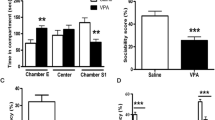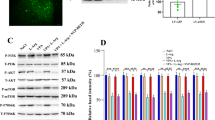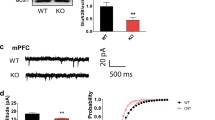Abstract
Valproic acid (VPA)-exposed rat offspring have demonstrated autism spectrum disorder (ASD) phenotypes and impaired N-methyl-D-aspartate receptor (NMDAR)-dependent long-term depression (LTD) in the lateral nucleus of the amygdala. NMDAR partial agonist D-cycloserine (DCS) has been reported to act as a cognitive enhancer by increasing the NMDAR response to improve autistic-like phenotypes in animals. However, the mechanism of DCS in alleviating the ASD is still unknown. Using combined behavioral, electrophysiological, and molecular approaches, we found that DCS administration rescued social interaction deficits and anxiety/repetitive-like behaviors observed in VPA-exposed offspring. In the amygdala synapses, DCS treatment reversed the decreased paired pulse ratio (PPR) and the impaired NMDAR-dependent LTD, increased the frequency and amplitude of miniature excitatory post-synaptic currents (mEPSCs), and resulted in a higher dendritic spine density at the amygdala synapses in the VPA-exposed offspring. Moreover, we found that DCS facilitated the removal of GluA2-containing α-amino-3-hydroxy-5-methyl-4-isoxazolepropionic acid receptors (GluA2/AMPARs) by inducing NMDAR-dependent LTD in the VPA-exposed offspring. We further established that the effects of DCS treatment, including increased GluA2/AMPAR removal and rescues of impaired social behavior, were blocked by Tat-GluA23Y, a GluA2-derived peptide that disrupted regulation of AMPAR endocytosis. These results provided the first evidence that rescue of the ASD-like phenotype by DCS is mediated by the mechanism of GluA2/AMPAR removal in VPA-exposed rat offspring.







Similar content being viewed by others
References
Rodier PM, Ingram JL, Tisdale B, Nelson S, Romano J (1996) Embryological origin for autism: developmental anomalies of the cranial nerve motor nuclei. J Comp Neurol 370(2):247–261. doi:10.1002/(SICI)1096-9861(19960624)370:2<247::AID-CNE8>3.0.CO;2-2
Rapin I, Tuchman RF (2008) Autism: definition, neurobiology, screening, diagnosis. Pediatr Clin N Am 55(5):1129–1146, viii. doi:10.1016/j.pcl.2008.07.005
Ratajczak HV (2011) Theoretical aspects of autism: causes—a review. J Immunotoxicol 8(1):68–79. doi:10.3109/1547691X.2010.545086
Lee EJ, Lee H, Huang TN, Chung C, Shin W, Kim K, Koh JY, Hsueh YP et al (2015) Trans-synaptic zinc mobilization improves social interaction in two mouse models of autism through NMDAR activation. Nat Commun 6:7168. doi:10.1038/ncomms8168
Rubenstein E, Wiggins LD, Lee LC (2015) A review of the differences in developmental, psychiatric, and medical endophenotypes between males and females with autism spectrum disorder. J Dev Phys Disabil 27(1):119–139. doi:10.1007/s10882-014-9397-x
Werling DM, Geschwind DH (2013) Sex differences in autism spectrum disorders. Curr Opin Neurol 26(2):146–153. doi:10.1097/WCO.0b013e32835ee548
Sztainberg Y, Zoghbi HY (2016) Lessons learned from studying syndromic autism spectrum disorders. Nat Neurosci 19(11):1408–1417. doi:10.1038/nn.4420
Won H, Lee HR, Gee HY, Mah W, Kim JI, Lee J, Ha S, Chung C et al (2012) Autistic-like social behaviour in Shank2-mutant mice improved by restoring NMDA receptor function. Nature 486(7402):261–265. doi:10.1038/nature11208
Chung W, Choi SY, Lee E, Park H, Kang J, Choi Y, Lee D, Park SG et al (2015) Social deficits in IRSp53 mutant mice improved by NMDAR and mGluR5 suppression. Nat Neurosci 18(3):435–443. doi:10.1038/nn.3927
Meldrum B, Garthwaite J (1990) Excitatory amino acid neurotoxicity and neurodegenerative disease. Trends Pharmacol Sci 11(9):379–387
Hofmann SG, Wu JQ, Boettcher H (2013) D-cycloserine as an augmentation strategy for cognitive behavioral therapy of anxiety disorders. Biol Mood Anxiety Disorders 3(1):11. doi:10.1186/2045-5380-3-11
Davis M (2011) NMDA receptors and fear extinction: implications for cognitive behavioral therapy. Dialogues Clin Neurosci 13(4):463–474
van Berckel BN, Evenblij CN, van Loon BJ, Maas MF, van der Geld MA, Wynne HJ, van Ree JM, Kahn RS (1999) D-cycloserine increases positive symptoms in chronic schizophrenic patients when administered in addition to antipsychotics: a double-blind, parallel, placebo-controlled study. Neuropsychopharmacology : official publication of the American College of Neuropsychopharmacology 21(2):203–210. doi:10.1016/S0893-133X(99)00014-7
Ren J, Li X, Zhang X, Li M, Wang Y, Ma Y (2013) The effects of intra-hippocampal microinfusion of D-cycloserine on fear extinction, and the expression of NMDA receptor subunit NR2B and neurogenesis in the hippocampus in rats. Prog Neuro-Psychopharmacol Biol Psychiatry 44:257–264. doi:10.1016/j.pnpbp.2013.02.017
Posey DJ, Kem DL, Swiezy NB, Sweeten TL, Wiegand RE, McDougle CJ (2004) A pilot study of D-cycloserine in subjects with autistic disorder. Am J Psychiatry 161(11):2115–2117. doi:10.1176/appi.ajp.161.11.2115
Urbano M, Okwara L, Manser P, Hartmann K, Herndon A, Deutsch SI (2014) A trial of D-cycloserine to treat stereotypies in older adolescents and young adults with autism spectrum disorder. Clin Neuropharmacol 37(3):69–72. doi:10.1097/WNF.0000000000000033
Wink LK, Minshawi NF, Shaffer RC, Plawecki MH, Posey DJ, Horn PS, Adams R, Pedapati EV et al (2017) D-cycloserine enhances durability of social skills training in autism spectrum disorder. Molecular Autism 8:2. doi:10.1186/s13229-017-0116-1
Minshawi NF, Wink LK, Shaffer R, Plawecki MH, Posey DJ, Liu H, Hurwitz S, McDougle CJ et al (2016) A randomized, placebo-controlled trial of D-cycloserine for the enhancement of social skills training in autism spectrum disorders. Molecular Autism 7:2. doi:10.1186/s13229-015-0062-8
Blundell J, Blaiss CA, Etherton MR, Espinosa F, Tabuchi K, Walz C, Bolliger MF, Sudhof TC et al (2010) Neuroligin-1 deletion results in impaired spatial memory and increased repetitive behavior. The Journal of neuroscience : the official journal of the Society for Neuroscience 30(6):2115–2129. doi:10.1523/JNEUROSCI.4517-09.2010
Ramanathan S, Woodroffe A, Flodman PL, Mays LZ, Hanouni M, Modahl CB, Steinberg-Epstein R, Bocian ME et al (2004) A case of autism with an interstitial deletion on 4q leading to hemizygosity for genes encoding for glutamine and glycine neurotransmitter receptor sub-units (AMPA 2, GLRA3, GLRB) and neuropeptide receptors NPY1R, NPY5R. BMC Med Genet 5:10. doi:10.1186/1471-2350-5-10
Mead AN, Morris HV, Dixon CI, Rulten SL, Mayne LV, Zamanillo D, Stephens DN (2006) AMPA receptor GluR2, but not GluR1, subunit deletion impairs emotional response conditioning in mice. Behav Neurosci 120(2):241–248. doi:10.1037/0735-7044.120.2.241
Li J, Chai A, Wang L, Ma Y, Wu Z, Yu H, Mei L, Lu L et al (2015) Synaptic P-Rex1 signaling regulates hippocampal long-term depression and autism-like social behavior. Proc Natl Acad Sci U S A 112(50):E6964–E6972. doi:10.1073/pnas.1512913112
Nakamoto M, Nalavadi V, Epstein MP, Narayanan U, Bassell GJ, Warren ST (2007) Fragile X mental retardation protein deficiency leads to excessive mGluR5-dependent internalization of AMPA receptors. Proc Natl Acad Sci U S A 104(39):15537–15542. doi:10.1073/pnas.0707484104
Rouaud E, Billard JM (2003) D-cycloserine facilitates synaptic plasticity but impairs glutamatergic neurotransmission in rat hippocampal slices. Br J Pharmacol 140(6):1051–1056. doi:10.1038/sj.bjp.0705541
Mao SC, Lin HC, Gean PW (2008) Augmentation of fear extinction by D-cycloserine is blocked by proteasome inhibitors. Neuropsychopharmacology : official publication of the American College of Neuropsychopharmacology 33(13):3085–3095. doi:10.1038/npp.2008.30
Wu HF, Chen PS, Chen YJ, Lee CW, Chen IT, Lin HC (2016) Alleviation of N-methyl-D-aspartate receptor-dependent long-term depression via regulation of the glycogen synthase kinase-3beta pathway in the amygdala of a valproic acid-induced animal model of autism. Mol Neurobiol. doi:10.1007/s12035-016-0074-1
Kim KC, Kim P, Go HS, Choi CS, Yang SI, Cheong JH, Shin CY, Ko KH (2011) The critical period of valproate exposure to induce autistic symptoms in Sprague-Dawley rats. Toxicol Lett 201(2):137–142. doi:10.1016/j.toxlet.2010.12.018
Crawley JN (2004) Designing mouse behavioral tasks relevant to autistic-like behaviors. Ment Retard Dev Disabil Res Rev 10(4):248–258. doi:10.1002/mrdd.20039
Pellow S, Chopin P, File SE, Briley M (1985) Validation of open:closed arm entries in an elevated plus-maze as a measure of anxiety in the rat. J Neurosci Methods 14(3):149–167
Lacroix L, Spinelli S, Heidbreder CA, Feldon J (2000) Differential role of the medial and lateral prefrontal cortices in fear and anxiety. Behav Neurosci 114(6):1119–1130
Pyter LM, Pineros V, Galang JA, McClintock MK, Prendergast BJ (2009) Peripheral tumors induce depressive-like behaviors and cytokine production and alter hypothalamic-pituitary-adrenal axis regulation. Proc Natl Acad Sci U S A 106(22):9069–9074. doi:10.1073/pnas.0811949106
Mao SC, Chang CH, Wu CC, Orejarena MJ, Manzoni OJ, Gean PW (2013) Inhibition of spontaneous recovery of fear by mGluR5 after prolonged extinction training. PLoS One 8(3):e59580. doi:10.1371/journal.pone.0059580
Zhou Q, Homma KJ, Poo MM (2004) Shrinkage of dendritic spines associated with long-term depression of hippocampal synapses. Neuron 44(5):749–757. doi:10.1016/j.neuron.2004.11.011
Lai KO, Ip NY (2013) Structural plasticity of dendritic spines: the underlying mechanisms and its dysregulation in brain disorders. Biochim Biophys Acta 1832(12):2257–2263. doi:10.1016/j.bbadis.2013.08.012
Biou V, Bhattacharyya S, Malenka RC (2008) Endocytosis and recycling of AMPA receptors lacking GluR2/3. Proc Natl Acad Sci U S A 105(3):1038–1043. doi:10.1073/pnas.0711412105
Man HY, Lin JW, Ju WH, Ahmadian G, Liu L, Becker LE, Sheng M, Wang YT (2000) Regulation of AMPA receptor-mediated synaptic transmission by clathrin-dependent receptor internalization. Neuron 25(3):649–662
Wang YT, Linden DJ (2000) Expression of cerebellar long-term depression requires postsynaptic clathrin-mediated endocytosis. Neuron 25(3):635–647
Ahmadian G, Ju W, Liu L, Wyszynski M, Lee SH, Dunah AW, Taghibiglou C, Wang Y et al (2004) Tyrosine phosphorylation of GluR2 is required for insulin-stimulated AMPA receptor endocytosis and LTD. EMBO J 23(5):1040–1050. doi:10.1038/sj.emboj.7600126
Kim J, Lee S, Park K, Hong I, Song B, Son G, Park H, Kim WR et al (2007) Amygdala depotentiation and fear extinction. Proc Natl Acad Sci U S A 104(52):20955–20960. doi:10.1073/pnas.0710548105
Gallagher M, Chiba AA (1996) The amygdala and emotion. Curr Opin Neurobiol 6(2):221–227
Baron-Cohen S, Ring HA, Bullmore ET, Wheelwright S, Ashwin C, Williams SC (2000) The amygdala theory of autism. Neurosci Biobehav Rev 24(3):355–364
Baxter MG, Croxson PL (2012) Facing the role of the amygdala in emotional information processing. Proc Natl Acad Sci U S A 109(52):21180–21181. doi:10.1073/pnas.1219167110
Huang TN, Chuang HC, Chou WH, Chen CY, Wang HF, Chou SJ, Hsueh YP (2014) Tbr1 haploinsufficiency impairs amygdalar axonal projections and results in cognitive abnormality. Nat Neurosci 17(2):240–247. doi:10.1038/nn.3626
Lin HC, Gean PW, Wang CC, Chan YH, Chen PS (2013) The amygdala excitatory/inhibitory balance in a valproate-induced rat autism model. PLoS One 8(1):e55248. doi:10.1371/journal.pone.0055248
Chen YW, Lin HC, Ng MC, Hsiao YH, Wang CC, Gean PW, Chen PS (2014) Activation of mGluR2/3 underlies the effects of N-acetylcystein on amygdala-associated autism-like phenotypes in a valproate-induced rat model of autism. Front Behav Neurosci 8:219. doi:10.3389/fnbeh.2014.00219
Markram K, Rinaldi T, La Mendola D, Sandi C, Markram H (2008) Abnormal fear conditioning and amygdala processing in an animal model of autism. Neuropsychopharmacol: Off Publ Am College Neuropsychopharmacology 33(4):901–912. doi:10.1038/sj.npp.1301453
O'Roak BJ, Vives L, Fu W, Egertson JD, Stanaway IB, Phelps IG, Carvill G, Kumar A et al (2012) Multiplex targeted sequencing identifies recurrently mutated genes in autism spectrum disorders. Science 338(6114):1619–1622. doi:10.1126/science.1227764
Kenny EM, Cormican P, Furlong S, Heron E, Kenny G, Fahey C, Kelleher E, Ennis S et al (2014) Excess of rare novel loss-of-function variants in synaptic genes in schizophrenia and autism spectrum disorders. Mol Psychiatry 19(8):872–879. doi:10.1038/mp.2013.127
Tarabeux J, Kebir O, Gauthier J, Hamdan FF, Xiong L, Piton A, Spiegelman D, Henrion E et al (2011) Rare mutations in N-methyl-D-aspartate glutamate receptors in autism spectrum disorders and schizophrenia. Transl Psychiatry 1:e55. doi:10.1038/tp.2011.52
Yoo HJ, Cho IH, Park M, Yang SY, Kim SA (2012) Family based association of GRIN2A and GRIN2B with Korean autism spectrum disorders. Neurosci Lett 512(2):89–93. doi:10.1016/j.neulet.2012.01.061
Lee EJ, Choi SY, Kim E (2015) NMDA receptor dysfunction in autism spectrum disorders. Curr Opin Pharmacol 20:8–13. doi:10.1016/j.coph.2014.10.007
Lee E, Lee J, Kim E (2016) Excitation/inhibition imbalance in animal models of autism spectrum disorders. Biol Psychiatry. doi:10.1016/j.biopsych.2016.05.011
Pilorge M, Fassier C, Le Corronc H, Potey A, Bai J, De Gois S, Delaby E, Assouline B et al (2016) Genetic and functional analyses demonstrate a role for abnormal glycinergic signaling in autism. Mol Psychiatry 21(7):936–945. doi:10.1038/mp.2015.139
Rinaldi T, Kulangara K, Antoniello K, Markram H (2007) Elevated NMDA receptor levels and enhanced postsynaptic long-term potentiation induced by prenatal exposure to valproic acid. Proc Natl Acad Sci U S A 104(33):13501–13506. doi:10.1073/pnas.0704391104
Kang J, Kim E (2015) Suppression of NMDA receptor function in mice prenatally exposed to valproic acid improves social deficits and repetitive behaviors. Front Mol Neurosci 8:17. doi:10.3389/fnmol.2015.00017
Dhawan J, Benveniste H, Luo Z, Nawrocky M, Smith SD, Biegon A (2011) A new look at glutamate and ischemia: NMDA agonist improves long-term functional outcome in a rat model of stroke. Future Neurol 6(6):823–834. doi:10.2217/fnl.11.55
Adeleye A, Shohami E, Nachman D, Alexandrovich A, Trembovler V, Yaka R, Shoshan Y, Dhawan J et al (2010) D-cycloserine improves functional outcome after traumatic brain injury with wide therapeutic window. Eur J Pharmacol 629(1–3):25–30. doi:10.1016/j.ejphar.2009.11.066
Malenka RC, Nicoll RA (1993) NMDA-receptor-dependent synaptic plasticity: multiple forms and mechanisms. Trends Neurosci 16(12):521–527
Hunt DL, Castillo PE (2012) Synaptic plasticity of NMDA receptors: mechanisms and functional implications. Curr Opin Neurobiol 22(3):496–508. doi:10.1016/j.conb.2012.01.007
Beattie EC, Carroll RC, Yu X, Morishita W, Yasuda H, von Zastrow M, Malenka RC (2000) Regulation of AMPA receptor endocytosis by a signaling mechanism shared with LTD. Nat Neurosci 3(12):1291–1300. doi:10.1038/81823
Lu W, Man H, Ju W, Trimble WS, MacDonald JF, Wang YT (2001) Activation of synaptic NMDA receptors induces membrane insertion of new AMPA receptors and LTP in cultured hippocampal neurons. Neuron 29(1):243–254
Chanda S, Aoto J, Lee SJ, Wernig M, Sudhof TC (2016) Pathogenic mechanism of an autism-associated neuroligin mutation involves altered AMPA-receptor trafficking. Mol Psychiatry 21(2):169–177. doi:10.1038/mp.2015.20
Li W, Xu X, Pozzo-Miller L (2016) Excitatory synapses are stronger in the hippocampus of Rett syndrome mice due to altered synaptic trafficking of AMPA-type glutamate receptors. Proc Natl Acad Sci U S A 113(11):E1575–E1584. doi:10.1073/pnas.1517244113
Mejias R, Adamczyk A, Anggono V, Niranjan T, Thomas GM, Sharma K, Skinner C, Schwartz CE et al (2011) Gain-of-function glutamate receptor interacting protein 1 variants alter GluA2 recycling and surface distribution in patients with autism. Proc Natl Acad Sci U S A 108(12):4920–4925. doi:10.1073/pnas.1102233108
Han M, Mejias R, Chiu SL, Rose R, Adamczyk A, Huganir R, Wang T (2017) Mice lacking GRIP1/2 show increased social interactions and enhanced phosphorylation at GluA2-S880. Behav Brain Res 321:176–184. doi:10.1016/j.bbr.2016.12.042
Tan HL, Queenan BN, Huganir RL (2015) GRIP1 is required for homeostatic regulation of AMPAR trafficking. Proc Natl Acad Sci U S A 112(32):10026–10031. doi:10.1073/pnas.1512786112
Duan TT, Tan JW, Yuan Q, Cao J, Zhou QX, Xu L (2013) Acute ketamine induces hippocampal synaptic depression and spatial memory impairment through dopamine D1/D5 receptors. Psychopharmacology 228(3):451–461. doi:10.1007/s00213-013-3048-2
Penzes P, Cahill ME, Jones KA, VanLeeuwen JE, Woolfrey KM (2011) Dendritic spine pathology in neuropsychiatric disorders. Nat Neurosci 14(3):285–293. doi:10.1038/nn.2741
Ultanir SK, Kim JE, Hall BJ, Deerinck T, Ellisman M, Ghosh A (2007) Regulation of spine morphology and spine density by NMDA receptor signaling in vivo. Proc Natl Acad Sci U S A 104(49):19553–19558. doi:10.1073/pnas.0704031104
Alvarez VA, Ridenour DA, Sabatini BL (2007) Distinct structural and ionotropic roles of NMDA receptors in controlling spine and synapse stability. J Neurosci 27(28):7365–7376. doi:10.1523/JNEUROSCI.0956-07.2007
Chen BS, Thomas EV, Sanz-Clemente A, Roche KW (2011) NMDA receptor-dependent regulation of dendritic spine morphology by SAP102 splice variants. J Neurosci 31(1):89–96. doi:10.1523/JNEUROSCI.1034-10.2011
Gupta SC, Yadav R, Pavuluri R, Morley BJ, Stairs DJ, Dravid SM (2015) Essential role of GluD1 in dendritic spine development and GluN2B to GluN2A NMDAR subunit switch in the cortex and hippocampus reveals ability of GluN2B inhibition in correcting hyperconnectivity. Neuropharmacology 93:274–284. doi:10.1016/j.neuropharm.2015.02.013
Lamprecht R, Farb CR, Rodrigues SM, LeDoux JE (2006) Fear conditioning drives profilin into amygdala dendritic spines. Nat Neurosci 9(4):481–483. doi:10.1038/nn1672
Radley JJ, Johnson LR, Janssen WG, Martino J, Lamprecht R, Hof PR, LeDoux JE, Morrison JH (2006) Associative Pavlovian conditioning leads to an increase in spinophilin-immunoreactive dendritic spines in the lateral amygdala. Eur J Neurosci 24(3):876–884. doi:10.1111/j.1460-9568.2006.04962.x
Calabrese B, Saffin JM, Halpain S (2014) Activity-dependent dendritic spine shrinkage and growth involve downregulation of cofilin via distinct mechanisms. PLoS One 9(4):e94787. doi:10.1371/journal.pone.0094787
Leuner B, Shors TJ (2004) New spines, new memories. Mol Neurobiol 29(2):117–130. doi:10.1385/MN:29:2:117
Acknowledgments
The authors would like to thank OxBioSci for editing the English in this manuscript and all of the research participants. This study was supported by grants MOST 105-2628-B-010-006–MY3, MOST 104-2314-B-006-030-MY3, MOST 103-2321-B-010-016, and MOST 99-2628-B-006-013-MY3 from the Ministry of Science and Technology of Taiwan. This study was also supported by Yen Tjing Ling Medical Foundation, Taiwan (CI-105-12); National Yang-Ming University-Far Eastern Memorial Hospital Joint Research Program (#NYMU-FEMH 106DN09); the Brain Research Center, National Yang-Ming University; and a grant from Ministry of Education, Aim for the Top University Plan, Taiwan. The funding institutions of this study had no further role in the study design, the collection, analysis, and interpretation of data; the writing of this paper; or the decision to submit it for publication.
Author information
Authors and Affiliations
Contributions
HC Lin and PS Chen conceived and designed the experiments. HF Wu, YT Hsu, CW Lee, TF Wang, and YJ Chen performed the experiments. HF Wu and PS Chen analyzed the data. PS Chen contributed reagents/materials/analysis tools. HF Wu and HC Lin wrote the paper.
Corresponding author
Ethics declarations
Conflict of Interest
The authors declare that they have no conflicts of interest.
Rights and permissions
About this article
Cite this article
Wu, HF., Chen, P.S., Hsu, YT. et al. D-Cycloserine Ameliorates Autism-Like Deficits by Removing GluA2-Containing AMPA Receptors in a Valproic Acid-Induced Rat Model. Mol Neurobiol 55, 4811–4824 (2018). https://doi.org/10.1007/s12035-017-0685-1
Received:
Accepted:
Published:
Issue Date:
DOI: https://doi.org/10.1007/s12035-017-0685-1




